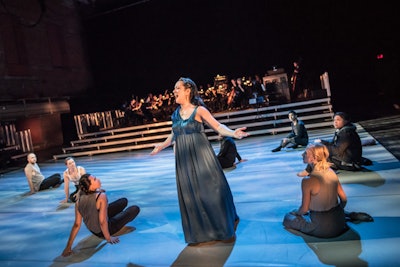As one of the most notable arts festivals in North America, Luminato has always delivered memorable arts-infused experiences during its annual run in Toronto. As last year’s festival celebrated its 10th anniversary with flashy events, which included a futuristic opening bash at the decommissioned Hearn Generating Station, this year’s festival was a bit more subdued, with the festival hub returning downtown.
But for its 11th edition, which took place June 14 to 25, festival organizers wanted to return to the event’s roots by focusing on Canadian artists.
“There are so many exciting and talented artists in this city and in this country,” said Josephine Ridge, the festival’s new artistic director. “To a large extent—again, going back to our founding principles—Luminato exists to enable them to realize their dreams and to showcase their work.”
Ridge, an Australian arts veteran who was previously the artistic director of the Melbourne Arts Festival, worked with festival C.E.O. Anthony Sargent to provide attendees with 12 days of programming. First on the agenda was moving the festival hub to David Pecaut Square. The hub provided attendees with free programming, which included performances in the Famous Spiegeltent: an intimate performance space reminiscent of traveling 1920s-style spiegeltents, which are European tents built from wood and canvas with mirrors inside. Ridge explained that the decision to bring the festival back downtown and use a range of venues was made to give visibility to Luminato as a festival of Toronto, not just a festival in Toronto.
“By placing the Famous Spiegeltent in David Pecaut Square, it was about reconnecting with a traditional space for Luminato,” said Ridge. “But it was also about this notion of placing a pop-up venue in the heart of a very busy and high-profile part of the city.”
While conceiving the 2017 program, Ridge and Sargent wanted to create a festival that felt relevant to Toronto today, and that would leave audience members feeling a connection to the programming, “I felt it was as important to look back to the roots of Luminato and its founding principles and goals as it was to look ahead to where we wanted to go,” said Ridge.
The festival’s opening-night event, Tributaries, which was curated by Indigenous producer Denise Bolduc, celebrated contemporary Indigenous artists and showcased a Luminato that was leaner and more focused on providing quality Canadian content.
Ridge stressed that it is the deep-seated belief in the importance of Luminato contributing to the cultural landscape—in defining ways—that will make a difference. One example from this year was “Life Reflected,” a multimedia symphonic performance that took place at the Sony Centre for the Performing Arts. The performance—which featured four women from the National Arts Centre Orchestra along with visuals and stage design by Montreal-based video production studio Normal—provided guests with an immersive motion-picture experience.
“Luminato exists to enable [artists] to realize their dreams and to showcase their work to the world,” said Ridge. “It is important that we strive to reach as many people as possible and that each work finds its intended audience.”
Here’s a look at highlights from Luminato’s 11th edition.


























